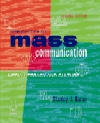 |
1 |  | 
Andrew Bradford's American Magazine, or a Monthly View of the Political State of the British Colonies |
|  | A) | was closed for failure to pay the Stamp Tax. |
|  | B) | had a long and prosperous run before closing during the Civil War. |
|  | C) | was the first magazine published in the Colonies. |
|  | D) | was distributed for free on street corners. |
 |
 |
2 |  | 
Social movements of the early 1800s, such as labor reform and abolition, |
|  | A) | scared away advertisers who feared controversy. |
|  | B) | helped U.S. magazines develop a look much different from their British predecessors. |
|  | C) | did little to attract female readers, magazines' core audience. |
|  | D) | all of the above |
 |
 |
3 |  | 
The expansion of the railroad, increased literacy, reduced cover prices, and __________ fueled the boom in interest in mass circulation magazines after the Civil War. |
|  | A) | interest in social movements |
|  | B) | a growing immigrant population |
|  | C) | the emergence of several well-known columnists |
|  | D) | the Postal Act of 1879 |
 |
 |
4 |  | 
Because of their ability to attract growing amounts of advertising in the late 1800s, magazines were able to |
|  | A) | dramatically reduce cover prices. |
|  | B) | reduce postage costs. |
|  | C) | make fuller use of color photography in their pages. |
|  | D) | all of the above |
 |
 |
5 |  | 
The original muckrakers |
|  | A) | were considered too controversial by most large circulation magazines and were therefore published only in specialized, political publications. |
|  | B) | rarely took on institutions that advertised in the pages of the magazines for whom they wrote. |
|  | C) | were welcomed by government as a check on powerful institutions |
|  | D) | were writers who agitated for change by targeting powerful political and industrial people and institutions. |
 |
 |
6 |  | 
The Crisis, first published in 1910 as the voice of the ____________, was founded and edited by noted African American intellectual W.E.B. DuBois. |
|  | A) | newly arrived European immigrant population |
|  | B) | Republican Party |
|  | C) | National Association for the Advancement of Colored People |
|  | D) | American Socialist Party |
 |
 |
7 |  | 
Of the approximately 22,000 magazines in operation in the United States, approximately 12,000 are considered |
|  | A) | profitable. |
|  | B) | national in scope. |
|  | C) | advertiser-friendly. |
|  | D) | general interest consumer magazines. |
 |
 |
8 |  | 
When you read Time, TV Guide, and The New Yorker, you're reading _____________ magazine. |
|  | A) | respectively, a trade, professional, and business |
|  | B) | respectively, an industrial, company, and sponsored |
|  | C) | a consumer |
|  | D) | an online |
 |
 |
9 |  | 
Controlled circulation refers to |
|  | A) | magazines that intentionally limit or control circulation to ensure a high proportion of demographically valuable readers. |
|  | B) | the rare situation in which the government limits or controls what a magazine publishes. |
|  | C) | a magazine provided at no cost to readers who meet some specific set of advertiser-attractive criteria. |
|  | D) | a magazine's efforts to control its circulation to ensure a broad-based reader demographic profile. |
 |
 |
10 |  | 
When you read Slate or Salon, you're reading _____________ magazine. |
|  | A) | respectively, a trade and professional |
|  | B) | respectively, an industrial and sponsored |
|  | C) | a consumer |
|  | D) | an online |
 |



 2002 McGraw-Hill Higher Education
2002 McGraw-Hill Higher Education